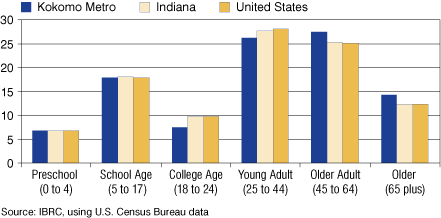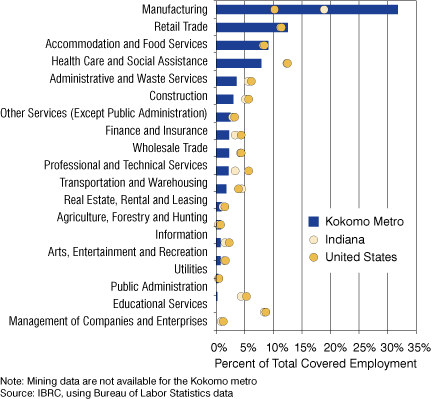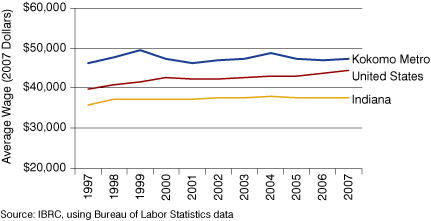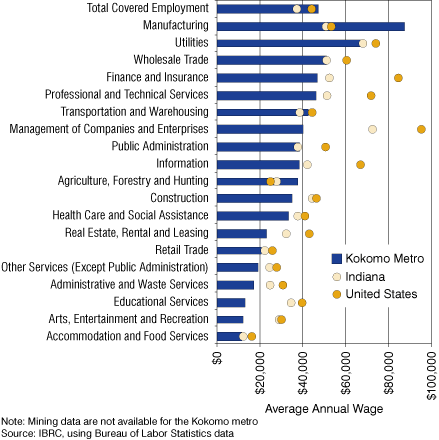The Kokomo Metro Story: Told by STATS Indiana
This is the ninth in a series of articles on Indiana's metropolitan statistical areas (metros). All the data used in this article can be found using the USA Counties and Metros Side-by-Side feature on STATS Indiana (www.stats.indiana.edu) unless otherwise noted.
The Area
The Kokomo metro is made up of Howard and Tipton counties, located north of the Indianapolis-Carmel metro. The largest city is Kokomo, also called “The City of Firsts.” Population in the metro has returned to its 1970 level, with approximately 99,800 people. In comparison, Indiana saw an increase of 22.1 percent over that time while the U.S. population grew 48.4 percent.
According to the most recent data, this change in population is largely due to net domestic out migration. International migration was positive for the Kokomo metro and so was the natural increase (births minus deaths) from 2006 to 2007. However, if we look at population by age data (the latest available is 2006), we find that the Kokomo metro has two age groups with a high percentage of its population compared to the United States and Indiana: the 45-to-64 age group and the 65-and-older age group (see Figure 1). The median age in the metro (39 years) is nearly three years older than the median age in Indiana.
Figure 1: Percent of Total Population by Age, 2006

Jobs and Wages
News about jobs in the Kokomo metro will come as no surprise to those familiar with the area. Unlike Indiana and the United States, both of which bounced back from the 2001 recession fairly well, the Kokomo metro has been steadily losing jobs. Kokomo, a manufacturing-intensive metro to say the least, shows the effects of the changing manufacturing industry more dramatically than the state or nation. Three out of every 10 people in the metro held a manufacturing job in 2007, far exceeding Indiana's 18.9 percent of employment in the manufacturing industry and the United State's 10.3 percent. Needless to say, with such a concentrated industry portfolio, the Kokomo metro was bound to take a hit when the manufacturing industry did so. The top three industries in the Kokomo metro made up more than half of employment in the metro in 2007 (see Figure 2).
Figure 2: Jobs as a Percent of Total Covered Employment, 2007

The good news for the Kokomo metro is that average wages per job consistently remained above Indiana and U.S. wages from 1997 to 2007. There were a couple of dips, as Figure 3 shows, in 2001 and again in 2005 and 2006, but the smallest margin between Kokomo and U.S. wages over the time span still shows Kokomo paying at least $2,800 more per job than the United States. However, growth in U.S. wages has been decreasing the margin for the past four years.
Figure 3: Average Wage per Job in the Kokomo Metro, Indiana and the United States, 1997 to 2007

In 2007, the manufacturing industry in the Kokomo metro paid an average wage that was $36,329 higher than Indiana's wages in manufacturing, with Kokomo workers making an average $87,471 per year (see Figure 4). Other industries that paid higher wages in Kokomo include the following:
- Agriculture, forestry and hunting ($9,760 higher than the state average)
- Transportation and warehousing ($3,649 higher than the state average)
- Public administration ($781 higher than the state average)
- Utilities industry ($62 higher than the state average)
Figure 4: Average Wage by Industry in the Kokomo Metro, Indiana and the United States, 2007

Conclusion
Population and jobs aren't looking the best at this point for the Kokomo metro area, but wages in the metro remain high. Although Delphi and Chrysler layoffs have been hard on the Kokomo metro economy, recent news articles suggest the area is attempting to bolster its economy in areas other than manufacturing. Tipton County is becoming part of a two-county arts trail that will provide people with the opportunity to explore the arts and culture of Tipton and Hamilton counties.1 The new U.S. 31 Kokomo corridor could also bring new business to the area.2 In the grand scheme of things, however, the Kokomo metro's ability to diversify across nonmanufacturing industries or alter its manufacturing path will likely determine how well the area economy will be doing over the next decade.
Notes
Molly Manns, Associate Editor
Indiana Business Research Center, Kelley School of Business, Indiana University
